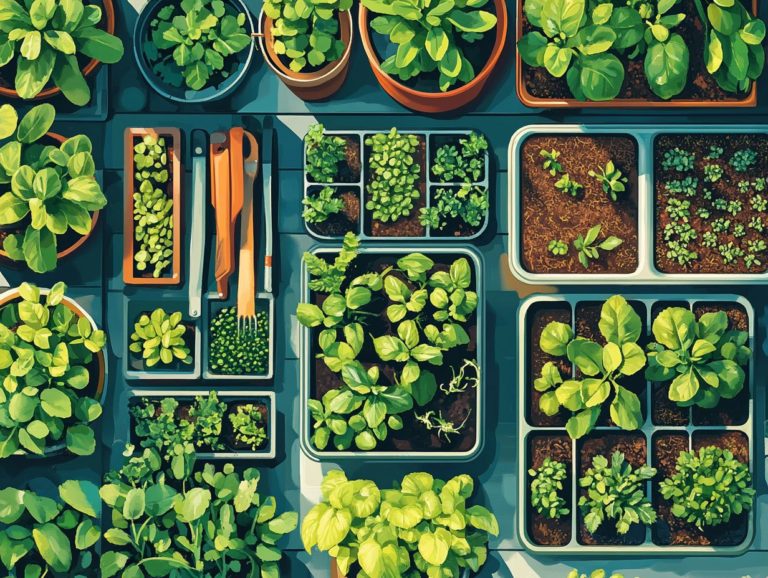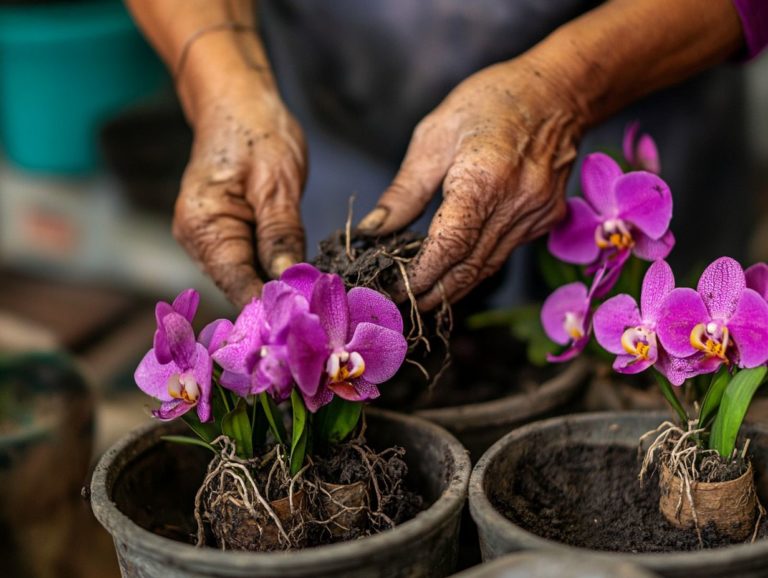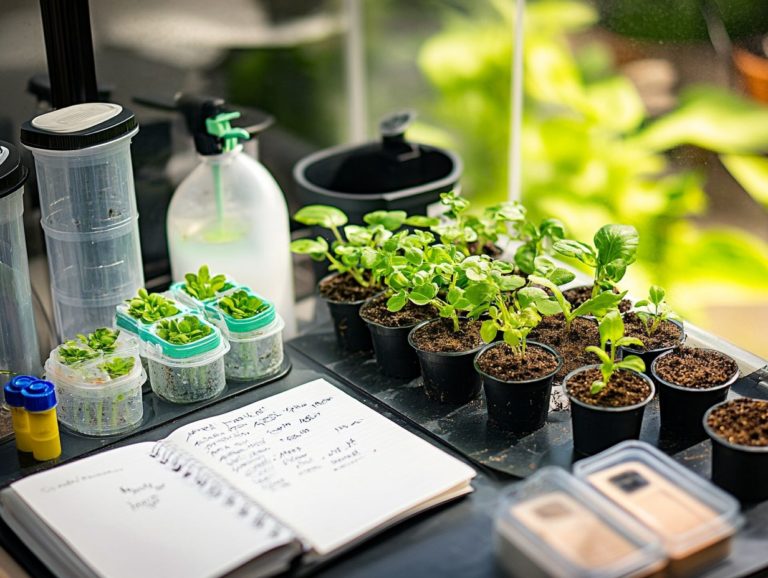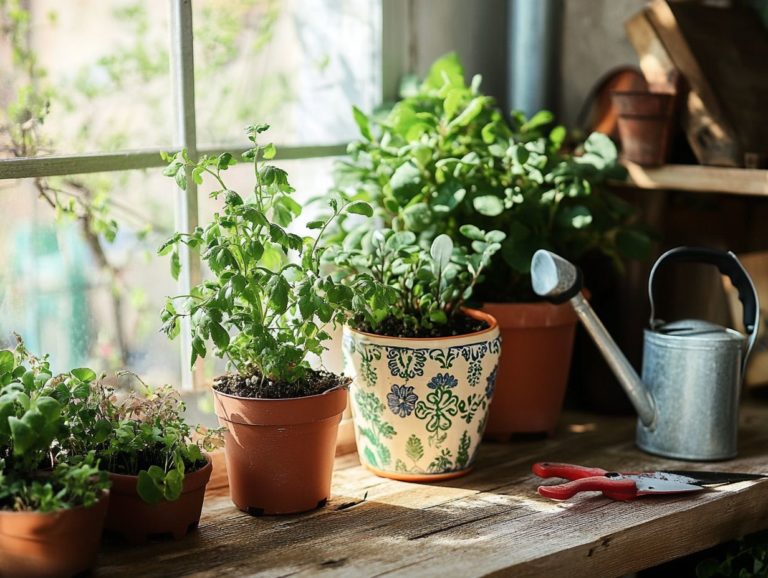The Role of Light in Plant Propagation
Plant propagation is an intriguing process that allows you to create new plants from existing ones. Light serves as a pivotal element in this journey.
This article delves into the essentials of plant propagation and explores how different types of light impact growth. It outlines the specific light requirements for various plants, effective lighting setups, and common pitfalls to avoid.
Whether you re a seasoned gardener or just beginning your horticultural adventure, harnessing the right light can transform your efforts in nurturing healthy, vibrant plants.
Contents
- Key Takeaways:
- Understanding Plant Propagation
- The Importance of Light in Plant Propagation
- Lighting Set-Up for Plant Propagation
- Types of Light for Plant Propagation
- Light Requirements for Different Plants
- Common Mistakes in Using Light for Plant Propagation
- Frequently Asked Questions
- 1. What is the role of light in plant propagation?
- 2. How does light affect plant propagation?
- 3. What types of light are important for plant propagation?
- 4. Can plants be propagated without light?
- 5. How much light is needed for successful plant propagation?
- 6. Can too much light be harmful for plant propagation?
Key Takeaways:
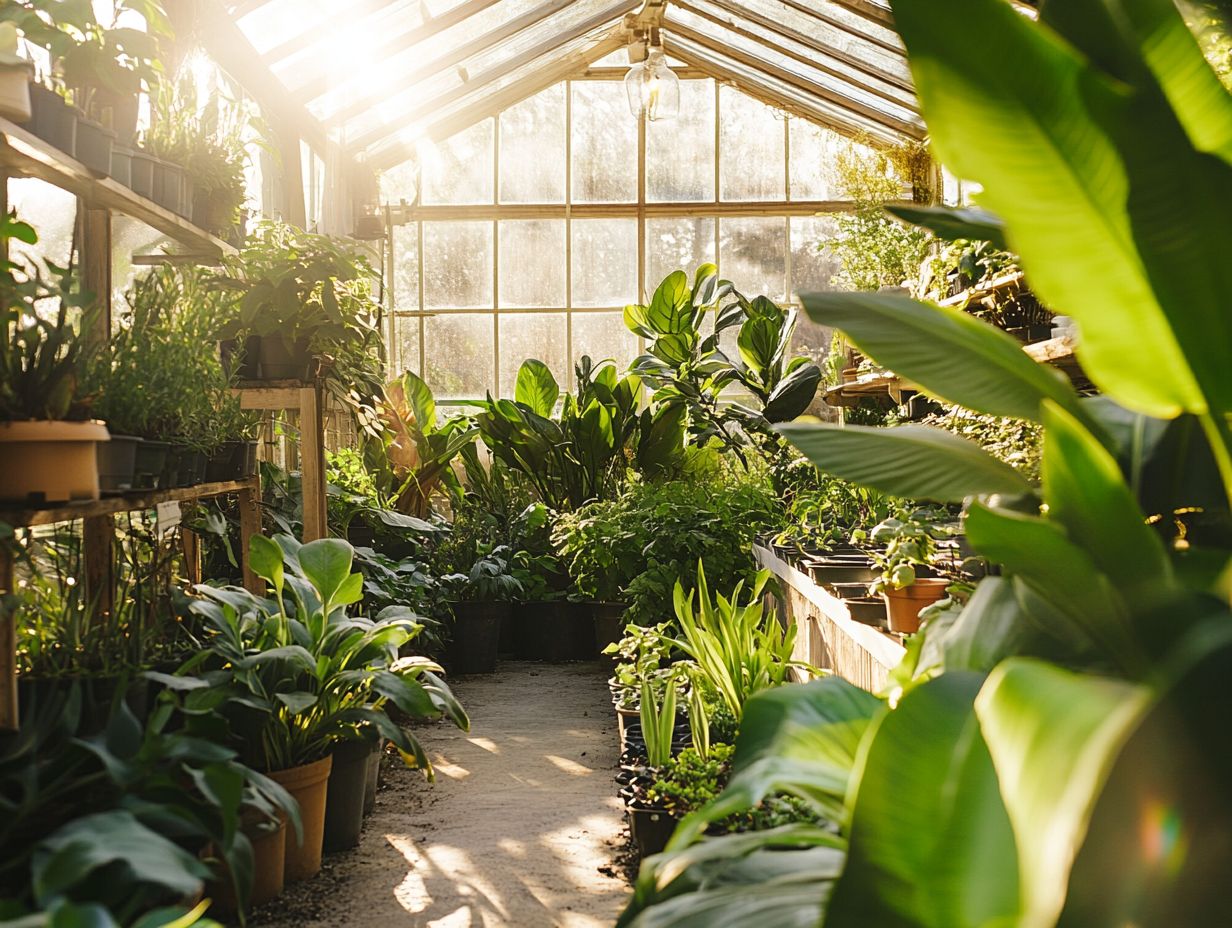
- Light is a crucial factor in plant propagation as it affects growth and development.
- Different types of light, natural and artificial, can be used for plant propagation depending on the specific needs of the plant.
- Matching the light requirements of plants to their specific types is essential for successful propagation.
Understanding Plant Propagation
Understanding plant propagation is essential for you as a horticulturist or gardener. It encompasses the reproduction of plants through various methods such as seed germination, cuttings, and vegetative propagation.
Mastering this process is your ticket to thriving plants! It helps young plants evolve into high-quality specimens with strong roots and compact forms. You must consider factors like light intensity, humidity, and air temperature, as these significantly influence the success of your propagation techniques.
Recognizing the importance of genetic expression during propagation enables you to better manage crop cycles, ensuring both quality and quantity in your gardening endeavors.
What is Plant Propagation?
Plant propagation encompasses the various methods to reproduce plants, whether through the sexual route of seeds or asexual techniques like cutting insertion. This vital horticultural practice enables you as a gardener or farmer to cultivate new plants, preserving the cherished traits and diversity of your garden.
Using the sexual method, you produce seedlings through the fertilization of flowers, allowing for genetic variation and a delightful mix of characteristics. Asexual methods such as layering, division, and taking cuttings generate clones of the parent plant, providing consistency in your garden’s features.
Each approach has unique advantages, making it essential for you to grasp the intricacies of plant propagation for successful cultivation and effective plant management.
The Importance of Light in Plant Propagation
Light is essential in plant propagation, influencing key physiological processes such as photosynthesis, seed germination, and root development. To enable young plants to flourish, you must ensure adequate light intensity and the right amount of light plants receive in a day.
Mastering these light conditions can significantly enhance your success with propagation techniques. Whether you’re leveraging natural sunlight or employing supplemental lighting, optimizing light exposure is crucial. For more insights, explore the science of light and plant care, as it elevates plant responses and fosters healthier growth cycles along with stronger root structures.
How Light Affects Plant Growth
Light plays a pivotal role in plant growth by driving photosynthesis the process through which plants transform light energy into chemical energy. This transformation is essential for their overall health and productivity.
Different light conditions like intensity, quality, and duration trigger varied responses in plant physiology. When light levels are right, chlorophyll absorbs wavelengths efficiently, optimizing energy conversion. Insufficient light can stunt growth and reduce yields, while excessive light risks photo-inhibition.
Growth regulators, such as auxins and gibberellins, help plants adapt to light fluctuations. They encourage elongation in low-light environments and regulate other vital processes, ensuring photosynthesis continues effectively, no matter the conditions.
Try implementing these propagation techniques to see how the right light can enhance your gardening experience!
Lighting Set-Up for Plant Propagation
Choosing the right equipment can be an exciting part of your gardening journey! A proper lighting setup is essential for successful plant propagation. It involves employing techniques that ensure consistent light management, which supports robust plant growth and development.
Equipment and Techniques for Optimal Lighting
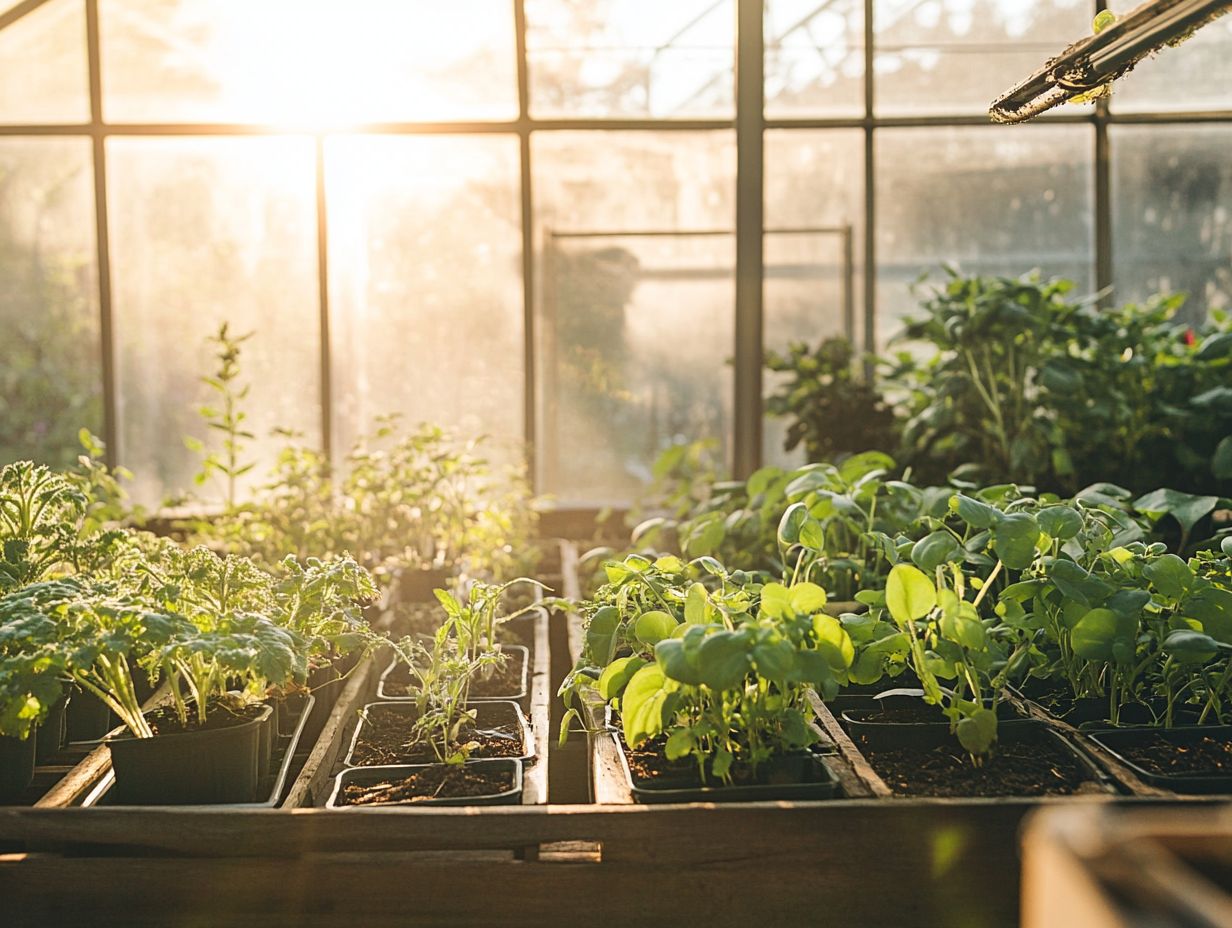
To achieve optimal lighting for plant propagation, it s crucial for you to utilize the right equipment and techniques, maximizing photosynthesis and rooting success.
You have a variety of lighting options at your disposal, each with its own unique benefits:
- LED grow lights: Stand out for their energy efficiency and minimal heat production, making them a top choice for indoor gardeners.
- Fluorescent lights: Offer broad-spectrum illumination that’s perfect for nurturing seedlings.
- High-intensity discharge (HID) lamps: Deliver powerful light but require careful management of heat and distance.
Implementing best practices for light management is key. Maintaining consistent light cycles and adjusting intensity according to your plants’ specific needs ensures they receive the adequate lighting necessary for robust growth and successful rooting.
Types of Light for Plant Propagation

In the realm of plant propagation, understanding the nuances of available light can significantly influence your success. Both natural and artificial light have distinct advantages and challenges for growers.
Natural light offers varied light and intensity that many plants have adapted to thrive under. Meanwhile, artificial light gives you the power to control these conditions, making it an invaluable tool for indoor gardening.
Natural light shifts throughout the day and year, often leaving indoor plants in the shadows or missing out on essential wavelengths. Artificial light allows you to fine-tune exposure and intensity to meet the specific needs of different species, ensuring optimal growth even in less-than-ideal circumstances.
Understanding how these two light sources interact is key to mastering your plant care.
Light Requirements for Different Plants
Each plant species possesses distinct light requirements that determine the optimal propagation environment for successful growth and development. It’s essential for you, as a grower, to align these light needs with the specific plants you are cultivating.
Matching Light Needs to Plant Types
Matching the light requirements of specific plant species to their ideal propagation conditions is essential for optimizing growth and ensuring healthy development.
For instance, some species thrive in bright, indirect light, while others need filtered light to avoid leaf burn. By grasping these nuances, you can fine-tune your propagation techniques, whether that means adjusting the distance of light sources or utilizing shades when necessary.
Recognizing the unique light preferences of different plants allows you to create tailored environments that foster strong root development and prevent common issues like stretching for light or stunted growth. These adjustments will enhance the vigor and vitality of your plants.
Common Mistakes in Using Light for Plant Propagation
Avoiding common mistakes in using light for plant propagation is essential for maximizing your success rates. By ensuring that your plants receive the appropriate light conditions, you’ll promote healthy growth and development.
Start experimenting with different light sources today to see how your plants respond!
Avoiding Pitfalls for Successful Propagation
To ensure successful propagation, you must navigate common pitfalls related to lighting that could hinder plant responses and compromise the development of robust roots.
Lighting is pivotal in photosynthesis. It affects both the growth rate and the overall health of your young plants. For those interested in expanding their gardening skills, understanding the science behind plant propagation is essential. Insufficient light can lead to etiolation, which is when plants stretch toward light, making them weak and tall. Conversely, excessive light can scorch leaves, ultimately stunting growth.
It’s crucial to understand the specific light requirements of each species. This understanding will guide you in selecting the most suitable propagation techniques. Inconsistent light exposure can disrupt the delicate balance necessary for optimal root formation. Therefore, keep your light source steady and suitable to boost your plants’ growth by considering the role of natural light in plant growth!
Frequently Asked Questions
1. What is the role of light in plant propagation?
Light fuels photosynthesis, which is essential for plant growth.
2. How does light affect plant propagation?
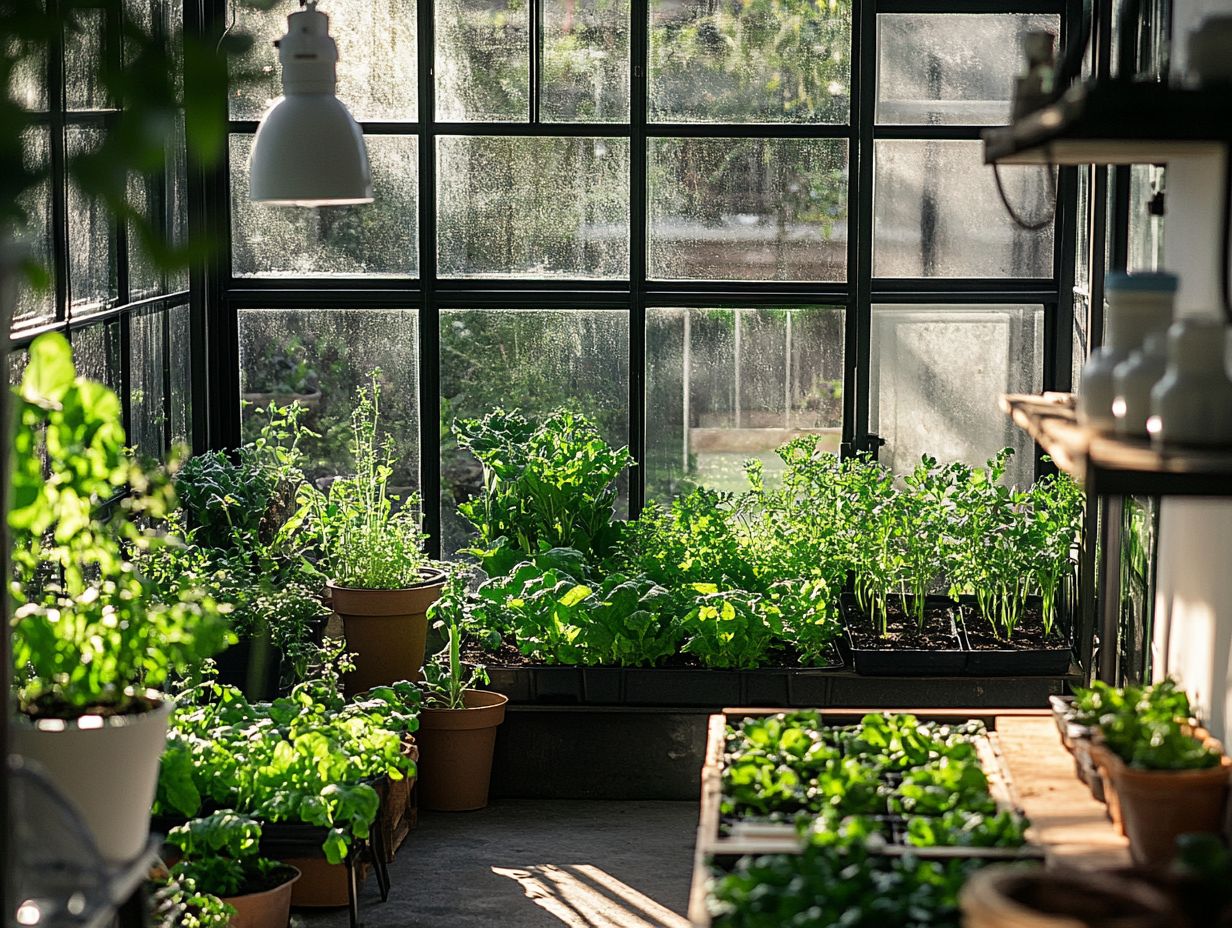
Light affects plant propagation by stimulating seed germination, promoting the growth of new roots and shoots, and influencing flower and fruit production.
3. What types of light are important for plant propagation?
Plants require both natural sunlight and artificial light for propagation. Natural sunlight provides the full spectrum of light, while artificial light can be adjusted to offer specific wavelengths that are most beneficial for plant growth.
4. Can plants be propagated without light?
While some plants can survive in low light conditions, they still need light for propagation. Without sufficient light, plants may become weak and leggy, making it difficult for them to develop and grow properly.
5. How much light is needed for successful plant propagation?
The amount of light needed varies by plant type and growth stage. Generally, plants require at least 6-8 hours of light per day, but some may need more or less depending on their specific needs.
6. Can too much light be harmful for plant propagation?
Yes, too much light can harm plant propagation. Prolonged exposure to intense or direct sunlight can lead to leaf scorching or overheating, impeding growth and development.

